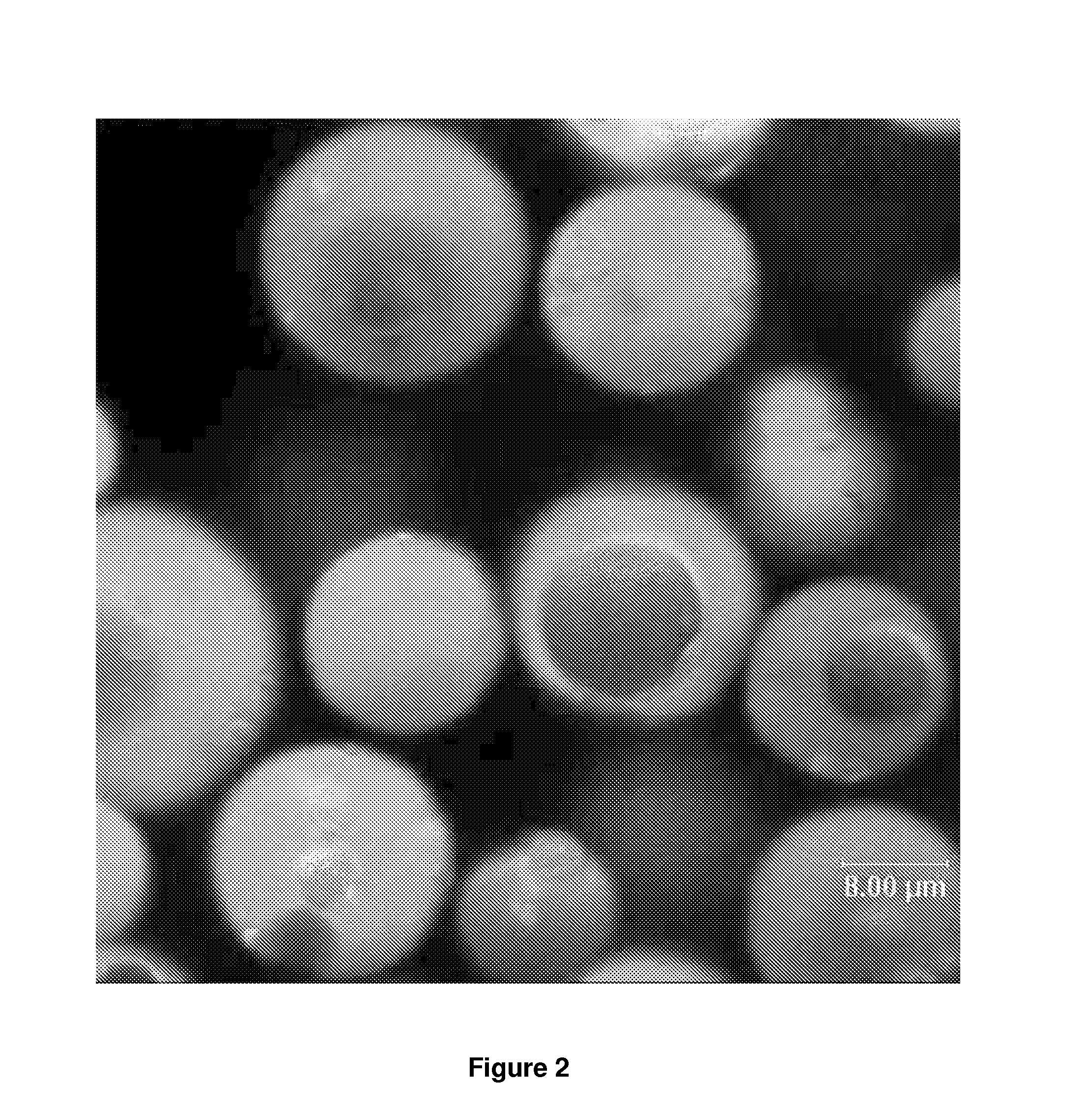Microcapsules and uses thereof
- Summary
- Abstract
- Description
- Claims
- Application Information
AI Technical Summary
Benefits of technology
Problems solved by technology
Method used
Image
Examples
example 1
Preparation of Microcapsules According to the Invention
[0100]A perfuming composition intended to be encapsulated was prepared by admixing the following ingredients, in the amounts indicated.
TABLE 1perfuming compositionIngredientsParts by weight (%)Hexyl salicylate20Romascone ®1)20Lilial ®2)20Lorysia ®3)20Verdox ®4)201)Methyl 2,2-dimethyl-6-methylene-1-cyclohexanecarboxylate, origin: Firmenich SA, Geneva, Switzerland2)3-(4-Tert-butylphenyl)-2-methylpropanal, origin: Givaudan SA, Vernier, Switzerland3)4-(1,1-Dimethylethyl)-1-cyclohexyl acetate, origin: Firmenich SA, Geneva, Switzerland4)2-tert-butyl-1-cyclohexyl acetate, origin: International Flavors and Fragrances,USA
[0101]The microcapsules of the invention were then prepared by the following process.
[0102]a) An amount of 1.55 g of Girard Reagent T (2-hydrazino-N,N,N-trimethyl-2-oxoethanammonium chloride, origin: Acros Organics) was dissolved in 1.07 g of water containing traces of fluorescin. This solution was mixed with 3.33 g of D...
example 2
Preparation of Microcapsules According to the Invention
[0106]a) An amount of 1.46 g of Girard Reagent T (2-hydrazino-N,N,N-trimethyl-2-oxoethanammonium chloride, origin: Acros Organics) was dissolved in 2.02 g of water containing traces of fluorescin. This solution was mixed with 6.75 g of Desmodur® N100 (solvent-free aliphatic polyisocyanate resin based on hexamethylene diisocyanate, origin: Bayer) using an Ultra Turax at 24000 rpm for 2 minutes. The resulting solution was kept at room temperature under magnetic stirring for 2 hours.
[0107]b) The reaction mixture was then dispersed in 30.1 g of the perfume described in Table 1 containing traces of DABCO (1,4-diazabicyclo [2.2.2]octane, origin: Fluka) and of Nile Red using an Ultra Turax at 24000 rpm for 5 minutes.
[0108]c) The system was then stirred continuously with vortex stirrer at 400 rpm. An aqueous solution of glycerol (origin: Fluka) was then prepared by dissolving 2.73 g of guanidine carbonate in 5.41 g of water. The obtaine...
example 3
Preparation of Microcapsules According to the Invention
[0110]a) An amount of 0.75 g of Girard Reagent T (2-hydrazino-N,N,N-trimethyl-2-oxoethanammonium chloride, origin: Acros Organics) was dissolved in 1.07 g of water containing traces of fluorescin. This solution was mixed with 3.33 g of Desmodur® N100 (solvent-free aliphatic polyisocyanate resin based on hexamethylene diisocyanate, origin: Bayer) using an Ultra Turax at 21500 rpm for 2 minutes. The resulting solution was kept at room temperature under magnetic stirring for 2 hours.
[0111]b) The reaction mixture was then dispersed in 15.1 g of the perfume described in Table 1 containing traces of Nile Red using an Ultra Turax at 21500 rpm for 2 minutes.
[0112]c) An aqueous solution of guanidine carbonate was then prepared by dissolving 0.6 g of guanidine carbonate (origin: Fluka) in 2.77 g of water. The obtained solution was gradually added to the reaction mixture obtained in step b). The system was then maintained at 70° C. for 3 h...
PUM
| Property | Measurement | Unit |
|---|---|---|
| Percent by mass | aaaaa | aaaaa |
| Percent by mass | aaaaa | aaaaa |
| Fraction | aaaaa | aaaaa |
Abstract
Description
Claims
Application Information
 Login to View More
Login to View More - R&D
- Intellectual Property
- Life Sciences
- Materials
- Tech Scout
- Unparalleled Data Quality
- Higher Quality Content
- 60% Fewer Hallucinations
Browse by: Latest US Patents, China's latest patents, Technical Efficacy Thesaurus, Application Domain, Technology Topic, Popular Technical Reports.
© 2025 PatSnap. All rights reserved.Legal|Privacy policy|Modern Slavery Act Transparency Statement|Sitemap|About US| Contact US: help@patsnap.com



